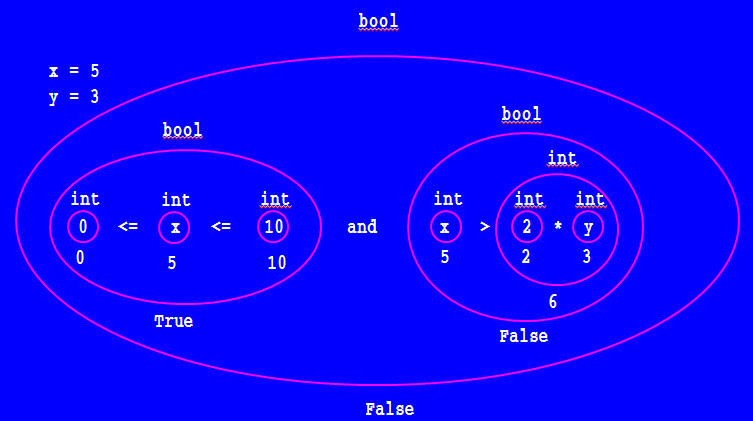| Problem Set |
To ensure that you understand all the material in this lecture, please solve
the the announced problems after you read the lecture.
If you get stumped on any problem, go back and read the relevant part of the
lecture.
If you still have questions, please get help from the Instructor, a CA, a Tutor,
or any other student.
- What are the results of each of the the following operators?
7/10 7./10 7/10. 7./10.
7/10 57/10 157/10 2157/10
7//10 57//10 157//10 2157/10
7%10 57%10 157%10 2157%10
- Analyze each of the following expressions, assuming
a = 1 and b=2 and write an
oval diagram for each.
(a+b)/2 a+b/2
100*a//b 100*(a//b) a//b*100
- Evaluate the expression (a+b - abs(a-b))//2 when
- a = 3 and b = 5
- a = 5 and b = 3.
Try a few other example values for a and b.
Describe in general terms what this expression evaluates to.
- Suppose that we define attendance = 3000 and
capacity=10000 the number of fans attending an event at a
stadium and the maximum number of fans possible at that
stadium respectively.
Which of the following expressions evaluates to 30, the percentage of
fans in the stadium?
What do the "incorrect" expressions evaluate to?
attendance//capacity
100*attendance//capacity
100*(attendance//capacity)
attendance//capacity*100
- Assume that we define year to be some int value.
Write an expression whose result is True whenever year
stores a leap year and false otherwise.
We define a leap year as any year that is a perfect multiple of of
4, but not if it is a perfect multiple of 100
(unless it is also a perfect multiple of 400).
Note that one number is a perfect multiple of another if the
remainder after division equals zero.
- Assume that we define x, y, and z to refer to
int values.
Write an expression that computes whether...
- ...x is odd
- ...x is a multiple of 20 (e.g., 20, 40, 60, ...)
Assume that zero is a positive number.
Write an expression that computes whether...
- ...x and y are both positive
- ...x and y have the same sign
(both are positive or both are negative)
- ...x and y have different signs
(one is positive and one is negative)
Write an expression that computes whether...
- ...all three names (x, y, and z) are bound
to equal values
- ...all three names (x, y, and z) are bound
to different values (none the same)
- ...two variables store the same value, but the third one is
different
- Assume that we specify two points in space by definint the x and y
coordinate of each using
x1, y1, x2, and y2 all which are
float.
Write an expression that computes...
- ...the distance between these points
- ...the slope of the line from the first point to the second
- ...whether both points lie on the same line from the origin
- ...whether the first point is above the second
- ...what quadrant the first point lies in (1st, 2nd, 3rd, or 4th)
- ...whether the two points lie in the same quadrant
- Assume that we specify a circle with the definitions
centerX, centerY, and radius
and a point by the defintions x ,y all which are
float.
Write an expression that computes whether or not the point lies inside
the circle (include points on the boundary).
- Assume that specify an interval by a pair of int values (the
ones at the beginning and end of the interval: 5 and 8
would specify the interval containing the numbers 5,
6, 7, and 8 inclusive.
We declare b1, e1, b2, adn e2 to
represent the beginning and end of two intervals (all int),
and x so represent some int value.
Note that we will guarantee that the intervals are "well formed":
b1 <= e1 and b2 <= e2.
- Write an expression that computes the number of values in an
interval beginning with b1 and ending with e1.
- Write an expression that computes whether...
- ...x is inside the first interval
- ...x is not inside the first interval
- ...x is inside the first interval but not the second
- ...x is inside either the first or second interval (or both)
- ...x is inside either the first or second interval (but not both)
- Write an expression that computes whether...
- ...the first interval is the same as the second
- ...the first interval ends before the second one begins
- ...the first interval ends on the same value as the second one begins
- ...the first interval is inside the second one
- ...the first interval and the second interval overlap (at least one common value)
- ...the first interval and the second interval do not overlap (no common values)
Draw pictures to help you visualize the relationships; choose your relational and logical
operators carefully, and try a few examples to convince yourself that your expressions are
correct.
For example, the following picture shows the first interval inside the second.

- Assume that we define x, y, and z to refer to
int values.
Write an expression that computes the minimum of these three values.
You may use the min function; its prototype is
min(int,int) -> int and it computes/returns the minimum of its
arguments.
- Assume that we defined
low, high,and x to be int and that we
guarantee that low <= high.
Write an expression whose result is low if x is smaller
than low, high if x is greater than
high, and x if it is between these values.
You may use the min and the max functions (see the
problem above).
|







